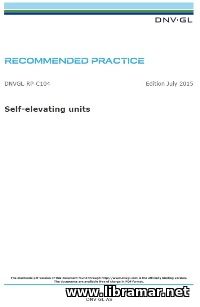 The present DNV GL released recommended practice contains official recommendations to be considered when performing strength analysis of the main structures of jack-up offshore units. The hull of the modern self-elevating platform usually rests on three or four legs, commonly vertical. Some special designs feature tilted legs - this is done to provide higher stability when the unit is elevated.
A drilling slot is normally cut in the aft side of the main deck, however some designs have the drilling derrick cantilevered over the unit's side. There are two bottom support concepts. Most of the self-elevating units have separate legs supported by the spud cans while other rigs have their legs connected to a huge mat preventing excessive penetration.
The present document will provide general information on the design features of the jack up rigs including general principles and stress design. The authors have paid attention to the environmental conditions to be taken into consideration as well as the design loads including deformation, environmental and accidental loads, global response analysis, structural strength and fatigue strength, accidental strength dealing with the damaged condition of the structure, stability analysis and requirements to the air gap. In the appendix you will find the simplified model of the lattice leg.
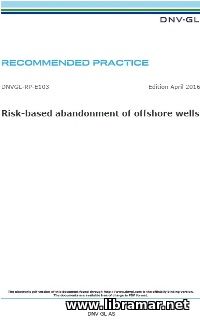 The content of this recommended practice is dealing with the risk based abandonment of the wells drilled offshore. The offshore wells being drilled commonly need permanent abandonment to get the subsurface pressure duly controlled and also to prevent the pore fluids from free flowing to the sea floor. The purpose of the so-called P&A standing for the plug and abandonment of the offshore wells is protection of the environment; of course, all safety standards are to be maintained.
The wells to plug and abandon offshore vary. Some of them require less complex plug and abandonment operations - they can normally be plugged using the simple P&A solution or existing drilling equipment of the platform. The other wells will require a rig capable of handling heavier P&A operations that, in turn, may require casing, tubing, milling, cement repairs etc.
The older wells sometimes lack basic documentation and paperwork required for the plug and abandonment - this is especially a case if this well has changed the owner. The main objective of this publication is to provide industry with the effective risk-based framework to be applied to the design of the well abandonment and is therefore a needful one for the offshore workers.
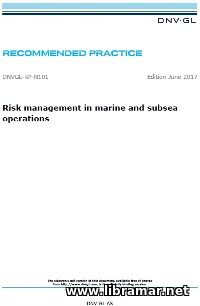 The provisions of this recommended practice developed and released by DNV GL are dealing with the application of the risk management to the marine and subsea operations. The opening section of the publication provides some introduction to the major principles of risk management and explain the definitions and terms commonly used.
The main part of the document is devoted to the risk management planning including not only general information on the process but also preparation of the proper risk management plan. The third section contains the references. There are four appendices containing some additional information relating to the general quality assurance and hazard identification activities plus risk deducing activities.
All marine operations including all associated support operations, shall be carefully assessed at the stage of conceptual design. If this is done then the quality assurance and risk management will positively influence the progress. All marine operations shall be designed with due attention paid to the resisting loads; they shall also be safe and practicable. The redundancy and backup philosophy shall also be addressed during the planning process...
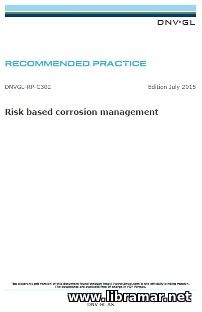 The present recommended practice by DNV GL is dealing with the risk based approach to the corrosion management. Today, more than sixty percent of the whole offshore fleet are past their twenty-year design age. Taking economic pressure into account, the offshore rigs are kept operating for much longer periods than they are designed for. In addition, there are numerous offshore rigs approaching this age.
It means that the operators of the rigs shall manage their material deterioration as necessary, i.e. pay close attention to corrosion and cracking. They shall also show the rig owners as well as the stakeholders and other interested parties the safety and integrity of the rigs in question. The content of this recommended practice commence s with the introduction to the problem followed by the section providing detailed process description.
The third section deals with the pre-assessment including identification of the potential risk for different zones while the next section covers risk ranking and screening. Three remaining sections of the document address the detailed examination stage of the process including assessment of the coating condition, remediation measures including cathodic protection, corrosion monitoring and inhibition, and lifecycle management.
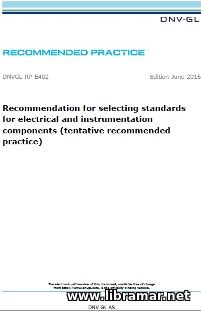 This pack of tentative recommended practices released by DNV GL class society is made of four documents providing recommendations to selection of the standards applicable to the electrical and instrumental components, piping components, steel bulk items, and structural steel materials.
The arrangement of the material in each of the publications is pretty standard - they all start with the introduction followed with the summary of standards, requirements and key parameters, information on the evaluation, and recommended requirements. Some of the papers contain additional information presented in the appendices to the main content.
The ultimate objective of these recommended practices is to provide interested parties with the uniform reference to be applied when selecting standards for the design and subsequent fabrication of the cables including low- and high-voltage cabling arrangements, instrument cables and tubes, clamps and fittings, piping insulation and ball valves, tertiary structural items, and many other aspects. The content of the documents will be of practical interest to the people directly engaged in certification of the above listed items.
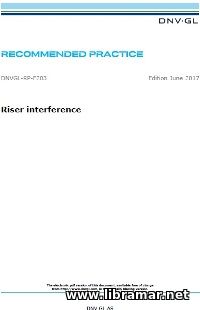 The DNV GL recommended practice relating to the riser interference. Today it is critically important to have an accurate methodology for the assessment of the riser interference, taking into account that the offshore exploration of oil and gas is moving to deeper waters. This, in turn, is causing increased risk of interference between risers. The general design practice traditionally applied to the marine risers is that the collisions must not be allowed under any conditions, from normal to extreme.
The present DNV GL publication is considering the established design analysis procedures as well as criteria applicable for the assessment of the marine riser interference. The objective of the volume is to provide the recommendation relating to the methodology for the engineering analysis as well as to give the rational criteria and technical guidance.
Apart from the introduction, the content of the document is arranged in four major parts covering the design approach mentioned above, hydrodynamic interaction, marine riser clearance assessment, and the one providing references. There are also three appendices giving information about the phenomenon of hydrodynamic interaction, analysis of the local impact stress applied to the steel pipes, and relevant analysis considerations.
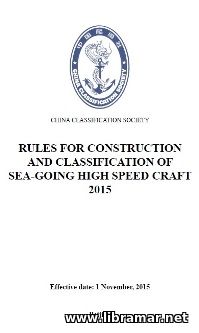 The China Register rules to be applied for the construction and classification of the sea going HSC, standing for the high speed craft. The main part of the document is arranged in eight chapters. The first introductory chapter contains general provisions including information about CCS. The second chapter is covering scope and conditions including general class requirements, class notations and characters, submission and subsequent approval of documentation, associated certification paperwork, liability matters etc.
The third chapter addresses the inspections of marine products together with the surveys of craft while the fourth chapter concentrates on the hull structure including relevant design requirements and loads, watertight integrity of the hull, scantlings of the hull constructed of aluminum, steel and FRP, hull vibration and calculations, weld design, corrosion prevention measures, etc.
The fifth chapter is dealing with the equipment and outfitting items including rudders and anchoring/mooring equipment. The last three chapters of the publication are covering machinery and electrical installations, and remote control systems as well as the safety and alarm systems. Three appendices contain supplementary information.
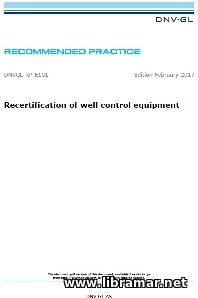 The recommended practice published by the DNV GL class society and providing information on recertification of the well control equipment with the ultimate aim to secure their functionality. In the content of this document recertification has been defines as the assessment of the continued conformity including the process attestation. It should be documented as being within specified acceptance limits for the particular system or equipment.
Note that the certificate renewal may also be considered a recertification. The document starts with the general introduction followed by the equipment description. The next section provides all required references including normative and informative references, while the fourth section contains definitions including verbal forms and abbreviations.
The sections making the main content of the present recommended practice address the recertification process itself together with the applicable qualification requirements, relevant recertification activities from kick-off meeting to final documentation and issuance of recertification statement, insufficient documentation for the equipment involved, and other important issues.
|







